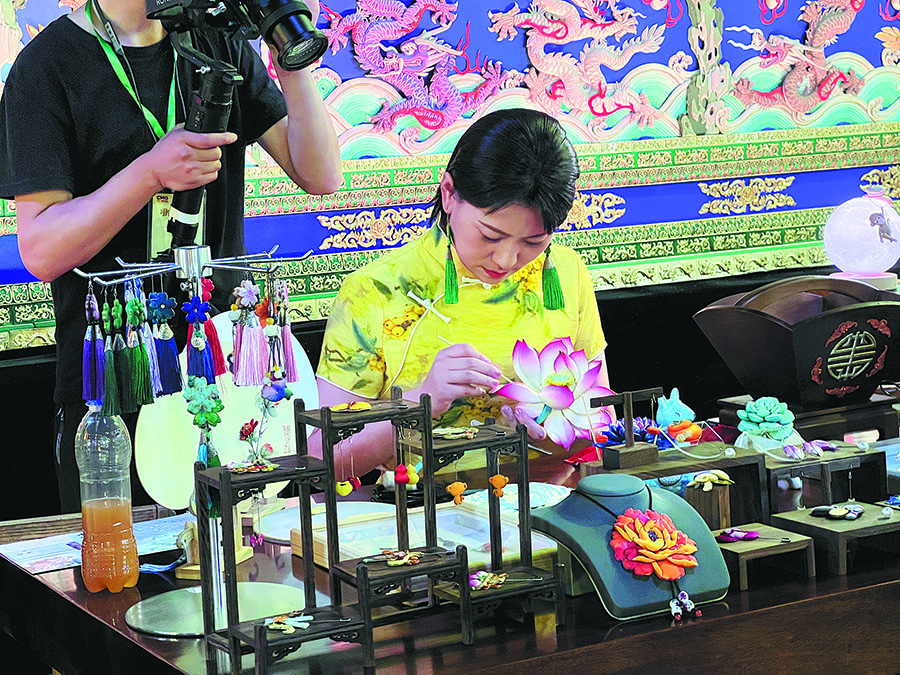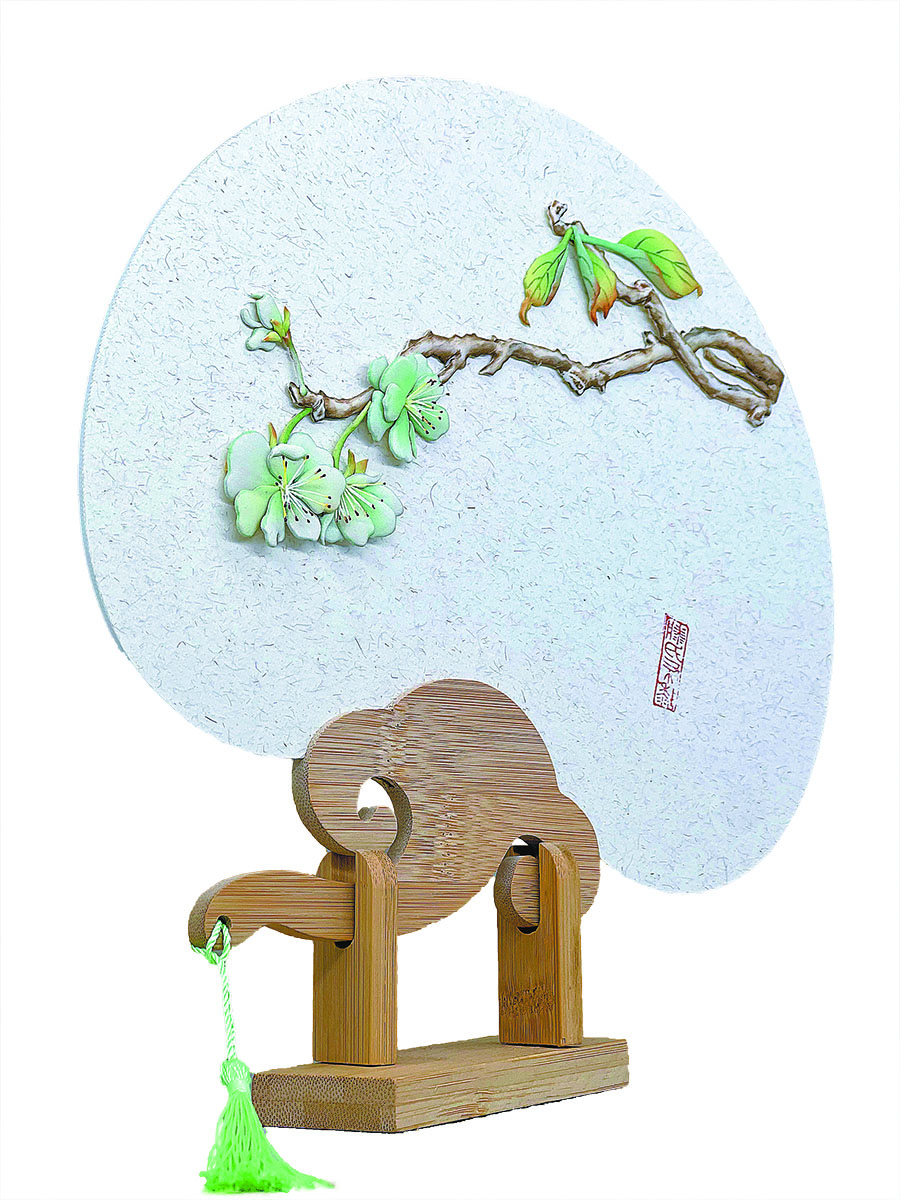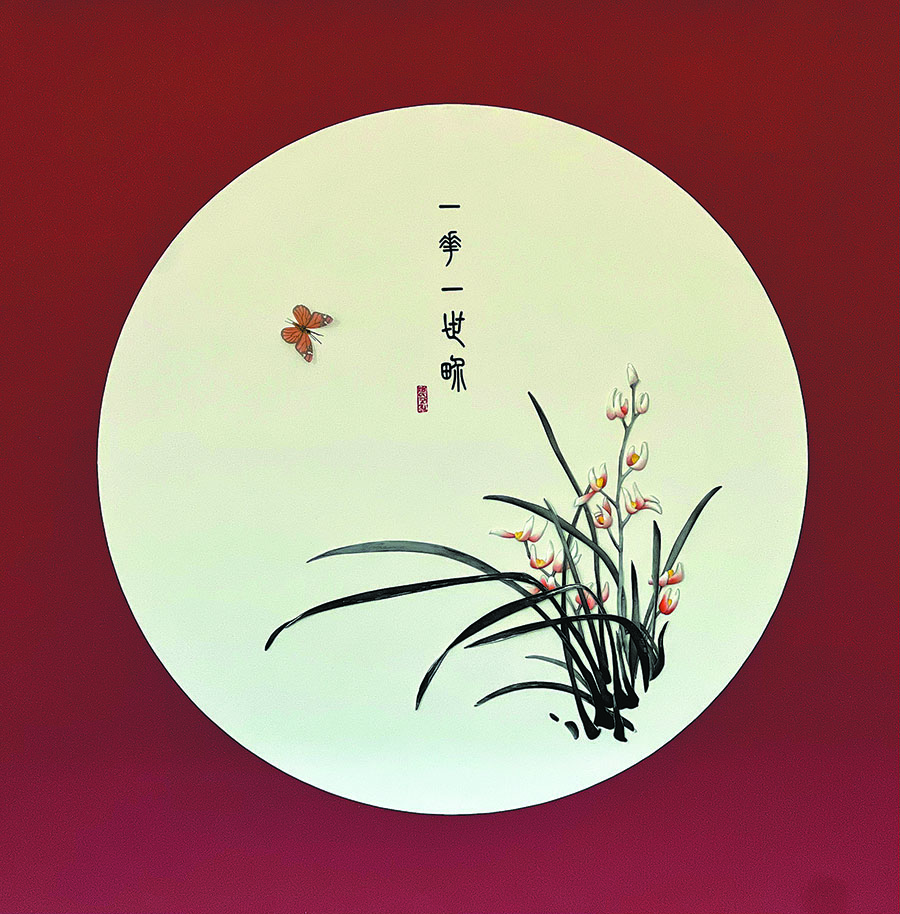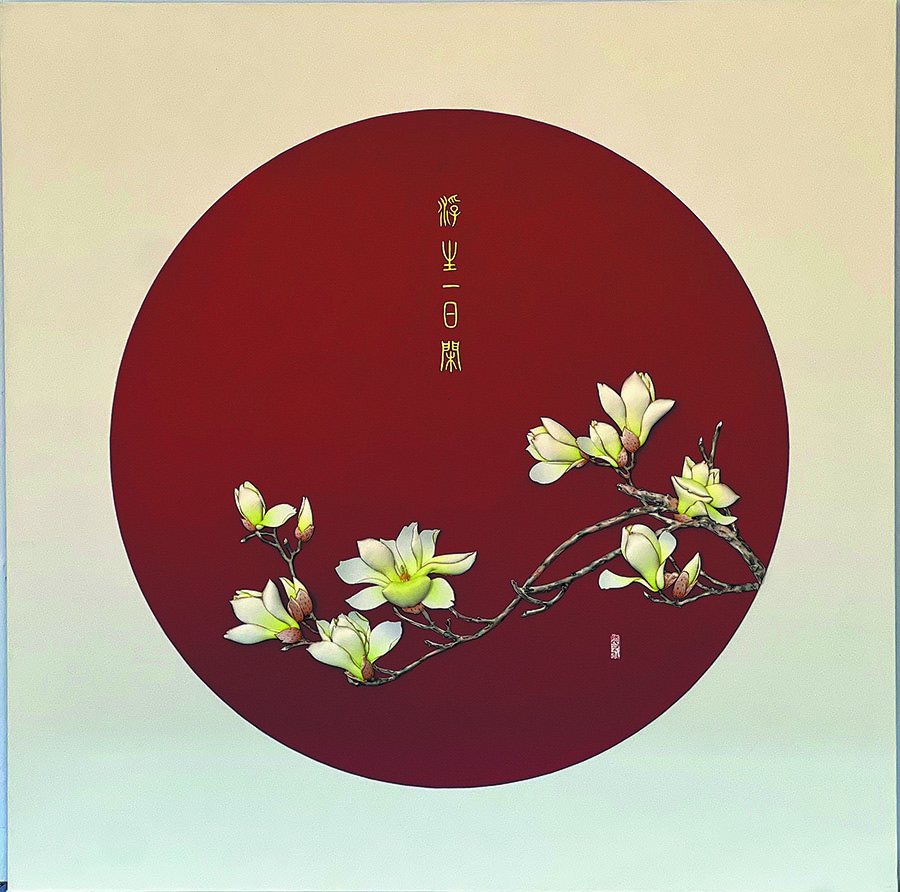A thread of culture knits the past to the present

Artisan Hao Ruxiang demonstrates the making of lotus flowers, using the buhu (cloth-pasted) painting craft, in Baoding, Hebei province.
Originating from folk customs, tradition that stretches back hundreds of years gets a fresh lease of life, Yang Feiyue reports.
Flowers and birds bursting with color, vivid human figures and dramatic landscapes seem to jump out of the picture frames hanging on the walls of artisan Hao Ruxiang's workshop.
From a distance, these exquisitely beautiful pictures appear to be fine paintings. Yet, up close, they resemble sculptural art, with rich layers and a three-dimensional feel.
The viewer can sometimes have a hard time reconciling the fact that they are actually crafted using fabrics, such as silk, skillfully pasted and layered together.
It is buhu (cloth-pasted) painting, which was named a national intangible cultural heritage by the Ministry of Culture and Tourism in 2014.
"It originated from the traditional folk art of the Manchu ethnic people, who would use needle and thread to create patterns as a means to mend boots, hats and clothing for practical and aesthetic purposes," says Hao from the Fengning Manchu autonomous county, Chengde, North China's Hebei province.
The art boasts a history of more than 300 years and is enjoying a new lease of life as Teng Teng, Hao's grandfather-in-law, made some groundbreaking innovations to the craft.
"He went from bu (mending) to hu (pasting), making the blossoms pop up from the surface," Hao explains.
Through decades of endeavor, Teng and his family have helped buhu painting to evolve, integrating the essence of numerous traditional crafts, ranging from painting, relief, embroidery, thangka, needlework, silhouette, paper-cutting, mounting, fabric collage and cloisonne.
Additionally, more than 100 materials have now been applied to add to the diverse expressions of the art.
"For example, we have meticulously pasted gold threads along the edges of flowers to create a better visual effect, which was originally inspired by my grandfather-in-law's application of cloisonne," Hao explains, adding that many techniques used to create the art are derived from practice.

A buhu painting fan featuring pear blossoms in three dimensions.
It takes at least nine steps to finish a relatively simple buhu painting, and for those complex ones, a total of 16 steps would be required, including design, drawing and its decomposition, plate-making, coloring, needlework, pasting, assembling, stacking and shaping.
"The decomposition of the drawing is relatively difficult, because you need to look ahead and visualize how each move can better present the object with a 3D effect afterward," Hao says.
As buhu painting carries the grace of traditional Chinese painting and the intricacy of embroidery, with its meticulous detailing and vibrant colors, it has been displayed in grand venues, such as the Great Hall of the People, and also adorns the homes of ordinary people.
Hao stumbled into the Teng-style buhu paintings in 2003.
"I was 22 years old and it was love at first sight," she recalls.
"It gives off the effect of an oil painting while maintaining the characteristics of traditional Chinese painting. You can get a good measure of the meticulousness of the detailed 'brushwork' and expressive style."
With a background in art, Hao decided to pursue the medium and made her way to Teng's workshop.
Initially, like everyone else, she worked on simple semifinished pasting. After completing her first one, Teng commented that her work was "already quite usable".
"It was very encouraging," Hao recalls.
After several months of continuous learning, she progressed from the pasting of simple leaves to 3D zodiac animals.
She still remembers a small tiger she made, very chubby and thick, too thick to fit into the frame.
"In fact, the thicker the cloth-pasted painting, the more challenging it is," she says.
"My grandfather-in-law was fulsome in his praise when he saw it, and later, during a family meal, he even took it out to show everyone. This really inspired me."
The learning experience also led to her marrying Teng's grandson, and the couple are committed to developing the art.
Hao admits that, as an inheritor, she feels a particular pressure because her grandfather-in-law has already elevated the art to a considerably high level.

A buhu painting for wall hanging, featuring butterfly and orchids.
To date, Hao has explored many innovative techniques of her own, and managed to deliver stunning examples of the art, especially those featuring the Great Wall and mountain landscapes.
However, her major focus has been on broadening the scope of this art form to ensure better inheritance and development, which she says is important, especially because machinery cannot fully replace manual work, with many elaborate techniques, such as pleating and 3D pasting.
"Such steps can only be done well by experienced craftsmen with a deep understanding of structural changes, as well as the evolving techniques," Hao says.
In 2018, when she learned that the county was establishing an intangible cultural heritage workshop to alleviate poverty, Hao wasted no time in starting to train local rural women in the art of buhu paintings.
She has managed to arrange several training sessions for more than 300 rural residents, while establishing an intangible cultural heritage workshop to offer ongoing training and employment opportunities for impoverished individuals.
This initiative has increased the annual income of impoverished households by more than 5,000 yuan ($699).
"To master the entire process is indeed challenging, and it requires tremendous patience and attention to detail," Hao says.
To ensure that rural students stay the course, Hao has students first focus on cloth pasting and assembling.
"As long as they meet the requirements, they will receive wages," Hao says.
This quick realization of income helped spark enthusiasm among the rural residents.
Zhao Shuyun, a local villager in her 50s, has followed Hao and has been making buhu paintings for the past few years.
"I started late, and can only paste some simple works," says Zhao, who runs a small grocery shop.
"It's nice that I can still make more than 8,000 yuan during the winter period, when I used to idle away the time at home," Zhao says, adding that she also takes delight in the fact that many of her friends have joined the trade and made the time working on the art very enjoyable.
Hao also started to make a point of publicizing the art at local schools, where she stages buhu painting class and interacts with students.
Learning tours to her workshop have also been arranged, and she has welcomed more than 5,000 students so far.
"Now, some schools in Fengning have incorporated intangible cultural heritage into their curriculum, and buhu painting has become a fixed elective course," Hao says.
It has given her confidence in the inheritance and promotion of the art.
"I hope my efforts can plant the seeds of intangible cultural heritage in the hearts of the next generation," she says.
On the other hand, Hao has kept coming up with ideas to integrate the art with items that cater to modern consumer tastes.
She has managed to develop accessories, ornaments, tabletop decorations, and bags, all carrying the buhu painting elements.
In particular, Hao has collaborated with fashion brands to make costumes using buhu painting techniques, and has caused a sensation at various events, such as the China Fashion Week.

A buhu paintings for wall hanging, featuring magnolia.
Related articles
-
 Vietnamese traditional costume Ao Dai
Vietnamese traditional costume Ao DaiMore
-
 Cultural plays bring immersive experience of Dunhuang culture to audience
Cultural plays bring immersive experience of Dunhuang culture to audienceMore
-
 For this fashion designer, hair is crowning glory
For this fashion designer, hair is crowning gloryMore
-
 Feature: China's local opera troupe stages performance in Nairobi amid growing Sino-Kenyan ties
Feature: China's local opera troupe stages performance in Nairobi amid growing Sino-Kenyan tiesMore
-
 Traditional Han clothing a major hit among Generation Z
Traditional Han clothing a major hit among Generation ZMore
-
 Miao embroiderer takes ethnic intangible heritage to world stage
Miao embroiderer takes ethnic intangible heritage to world stageMore
